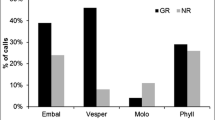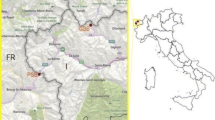Abstract
Time of peak bat activity during the night differs among bat species due to temperature, prey availability, habitat availability, and/or interactions between species. Habitat availability is altered in urban areas, which may affect insect prey availability and interspecies interactions. Our objectives were to use mobile acoustic monitoring to determine when bat species were active in a single night in urban and nonurban sites and if nightly bat activity patterns differed in urban versus nonurban sites. Bat echolocation call sequences were recorded using Anabat acoustic detectors while driving transects through the night at five sites (three “urban” and two “nonurban”) located in the Piedmont region of north-central North Carolina from May through August 2016. Transects were driven three times per night starting 45 min, 180 min, and 300 min after sunset. Recorded echolocation call sequences were analyzed manually using AnalookW and automatically using Bat Call Identification and Echoclass software. Total bat activity was not different between urban and nonurban sites. However, total bat activity was lower later in the night in urban sites, but stayed the same in nonurban sites. Species specifically, there were more Eptesicus fuscus, Lasionycteris noctivagans, and Tadarida brasiliensis call sequences and fewer Lasiurus borealis, Nycticeius humeralis, and Perimyotis subflavus call sequences in urban sites than nonurban sites. There were also fewer E. fuscus, L. noctivagans, and N. humeralis call sequences later in the night in both urban and nonurban sites. Only Lasiurus borealis activity in urban sites later in the night reduced and L. borealis activity in nonurban sites remained at the same. These results suggest that bats in urban areas partition time differently, which is important to consider for urban conservation efforts and planning.


Similar content being viewed by others
References
Adams RA, Thibault KM (2006) Temporal resource partitioning by bats at water holes. J Zool 270:466–472. https://doi.org/10.1111/j.1469-7998.2006.00152.x
Agosta SJ, Morton D, Marsh BD, Kuhn KM (2005) Nightly, seasonal, and yearly patterns of bat activity at night roosts in the central Appalachians. J Mammal 86:1210–1219
Avila-Flores R, Fenton MB (2005) Use of spatial features by foraging insectivorous bats in a large urban landscape. J Mammal 86:1193–1204. https://doi.org/10.1644/04-MAMM-A-085R1.1
Barclay RMR (1985) Long- versus short-range foraging strategies of hoary (Lasiurus cinereus) and silver-haired (Lasionycteris noctivagans) bats and the consequences for prey selection. Can J Zool 63:2507–2515. https://doi.org/10.1139/z85-371
Bennett VJ, Sparks DW, Zollner PA (2013) Modeling the indirect effects of road networks on the foraging activities of bats. Landsc Ecol 28:979–991. https://doi.org/10.1007/s10980-013-9874-0
Bennie JJ, Duffy JP, Inger R, Gaston KJ (2014) Biogeography of time partitioning in mammals. Proc Natl Acad Sci U S A 111:13727–13732. https://doi.org/10.1073/pnas.1216063110
Berthinussen A, Altringham J (2012) The effect of a major road on bat activity and diversity. J Appl Ecol 49:82–89. https://doi.org/10.1111/j.1365-2664.2011.02068.x
Best TL, Geluso KN, Ammerman LK (2003) Summer foraging range of Mexican free-tailed bats (Tadarida brasiliensis mexicana) from Carlsbad cavern, New Mexico. Southwest Nat 48:590–596. https://doi.org/10.1894/0038-4909(2003)048<0590:SFROMF>2.0.CO;2
Britzke ER, Herzog C (2009) Using acoustic surveys to monitor population trends in bats. U.S. Army Engineer Research and Development Center, Vicksburg
Coleman JL, Barclay RMR (2012) Urbanization and the abundance and diversity of prairie bats. Urban Ecosyst 15:87–102. https://doi.org/10.1007/s11252-011-0181-8
Dixon MD (2011) Relationship between land cover and insectivorous bat activity in an urban landscape. Urban Ecosyst 15:683–695. https://doi.org/10.1007/s11252-011-0219-y
Duchamp JE, Sparks DW, Whitaker JO (2004) Foraging-habitat selection by bats at an urban-rural interface: comparison between a successful and a less successful species. Can J Zool 82:1157–1164
Dzal Y, McGuire LP, Veselka N, Fenton MB (2011) Going, going, gone: the impact of white-nose syndrome on the summer activity of the little brown bat (Myotis lucifugus). Biol Lett 7:392–394. https://doi.org/10.1098/rsbl.2010.0859
Ethier K, Fahrig L (2011) Positive effects of forest fragmentation, independent of forest amount, on bat abundance in eastern Ontario, Canada. Landsc Ecol 26:865–876. https://doi.org/10.1007/s10980-011-9614-2
Fabianek F, Gagnon D, Delorme M (2011) Bat distribution and activity in Montreal Island green spaces: responses to multi-scale habitat effects in a densely urbanized area. Ecoscience -QUEBEC 18:9–17
Frick WF, Puechmaille SJ, Hoyt JR, Nickel BA, Langwig KE, Foster JT, Barlow KE, Bartonička T, Feller D, Haarsma AJ, Herzog C, Horáček I, van der Kooij J, Mulkens B, Petrov B, Reynolds R, Rodrigues L, Stihler CW, Turner GG, Kilpatrick AM (2015) Disease alters macroecological patterns of north American bats. Glob Ecol Biogeogr 24:741–749
Geggie JF, Fenton MB (1985) A comparison of foraging by Eptesicus fuscus (Chiroptera: Vespertilionidae) in urban and rural environments. Can J Zool 63:263–266. https://doi.org/10.1139/z85-040
Gehrt SD, Chelsvig JE (2003) Bat activity in an urban landscape: patterns at the landscape and microhabitat scale. Ecol Appl 13:939–950
Gehrt SD, Chelsvig JE (2004) Species-specific patterns of bat activity in an urban landscape. Ecol Appl 14:625–635. https://doi.org/10.1890/03-5013
Homer CG, Dewitz JA, Yang L et al (2015) Completion of the 2011 National Land Cover Database for the conterminous United States-representing a decade of land cover change information. Photogramm Eng Remote Sens 81:345–354
Jachowski DS, Dobony CA, Coleman LS, Ford WM, Britzke ER, Rodrigue JL (2014) Disease and community structure: white-nose syndrome alters spatial and temporal niche partitioning in sympatric bat species. Divers Distrib 20:1002–1015. https://doi.org/10.1111/ddi.12192
Jung K, Kalko EKV (2010) Where forest meets urbanization: foraging plasticity of aerial insectivorous bats in an anthropogenically altered environment. J Mammal 91:144–153
Kalcounis MC, Hobson KA, Brigham RM, Hecker KR (1999) Bat activity in the boreal forest: importance of stand type and vertical strata. J Mammal 80:673–682. https://doi.org/10.2307/1383311
Krauel JJ, LeBuhn G (2016) Patterns of bat distribution and foraging activity in a highly urbanized temperate environment. PLoS One 11:e0168927. https://doi.org/10.1371/journal.pone.0168927
Kronfeld-Schor N, Dayan T (2003) Partitioning of time as an ecological resource. Annu Rev Ecol Evol Syst 34:153–181. https://doi.org/10.1146/annurev.ecolsys.34.011802.132435
Kunz TH (1973) Resource utilization: temporal and spatial components of bat activity in central Iowa. J Mammal 54:14–32. https://doi.org/10.2307/1378869
Kunz TH (1982) Ecology of bats. Springer, New York
Kunz TH, Fenton MB (2006) Bat ecology. University of Chicago Press, Chicago
Kunz TH, Parsons S (2009) Ecological and behavioral methods for the study of bats. Johns Hopkins University Press, Baltimore
Kunz TH, Racey PA (1998) Bat biology and conservation. Smithsonian Institution Press, Washington, D.C.
Kurta A, Teramino JA (1992) Bat community structure in an urban park. Ecography 15:257–261
Li H, Kalcounis-Rueppell M (2018) Separating the effects of water quality and urbanization on temperate insectivorous bats at the landscape scale. Ecol Evol 8:667–678. https://doi.org/10.1002/ece3.3693
Li H, Wilkins KT (2014) Patch or mosaic: bat activity responds to fine-scale urban heterogeneity in a medium-sized city in the United States. Urban Ecosyst Salzbg 17:1013–1031. https://doi.org/10.1007/s11252-014-0369-9
Li H, Wilkins KT (2015) Selection of building roosts by Mexican free-tailed bats (Tadarida brasiliensis) in an urban area. Acta Chiropterologica 17:321–330. https://doi.org/10.3161/15081109ACC2015.17.2.007
Loeb SC, Rodhouse JT et al (2015) A plan for the North American bat monitoring program (NABat). Gen Tech Rep SRS-208 Asheville NC US Dep Agric For Serv South Res Stn 208:1–100
Luck GW, Smallbone L, Threlfall C, Law B (2013) Patterns in bat functional guilds across multiple urban centres in south-eastern Australia. Landsc Ecol 28:455–469. https://doi.org/10.1007/s10980-012-9842-0
May RM, MacArthur RH (1972) Niche overlap as a function of environmental variability. Proc Natl Acad Sci U S A 69:1109–1113
McGarigal K, Cushman SA, Ene E (2012) FRAGSTATS v4: Spatial pattern analysis program for categorical and continuous maps. Computer software program produced by the authors at the University of Massachusetts, Amherst. http://www.umass.edu/landeco/research/fragstats/fragstats.html. Accessed 27 Jan 2016
Mendes ES, Pereira MJR, Marques SF, Fonseca C (2014) A mosaic of opportunities? Spatio-temporal patterns of bat diversity and activity in a strongly humanized Mediterranean wetland. Eur J Wildl Res 60:651–664
Morris AD, Miller DA, Kalcounis-Rueppell MC (2009) Use of forest edges by bats in a managed pine forest landscape. J Wildl Manag 74:26–34. https://doi.org/10.2193/2008-471
Neubaum DJ, Wilson KR, O’shea TJ (2007) Urban maternity-roost selection by big brown bats in Colorado. J Wildl Manag 71:728–736. https://doi.org/10.2193/2005-684
Nunes H, Rocha FL, Cordeiro-Estrela P (2017) Bats in urban areas of Brazil: roosts, food resources and parasites in disturbed environments. Urban Ecosyst 20:953–969. https://doi.org/10.1007/s11252-016-0632-3
O’Farrell MJ, Miller BW, Gannon WL (1999) Qualitative identification of free-flying bats using the AnaBat detector. J Mammal 80:11–23. https://doi.org/10.2307/1383203
Razgour O, Korine C, Saltz D (2011) Does interspecific competition drive patterns of habitat use in desert bat communities? Oecologia 167:493–502
Rodríguez-Aguilar G, Orozco-Lugo CL, Vleut I, Vazquez L-B (2017) Influence of urbanization on the occurrence and activity of aerial insectivorous bats. Urban Ecosyst 20:477–488. https://doi.org/10.1007/s11252-016-0608-3
Russo D, Ancillotto L (2015) Sensitivity of bats to urbanization: a review. Mamm Biol - Z Für Säugetierkd 80:205–212. https://doi.org/10.1016/j.mambio.2014.10.003
Rydell J, Entwistle A, Racey PA (1996) Timing of foraging flights of three species of bats in relation to insect activity and predation risk. Oikos 76:243–252. https://doi.org/10.2307/3546196
Schoener TW (1974) Resource partitioning in ecological communities. Science 185:27–39
Shochat E, Warren PS, Faeth SH, et al (2006) From patterns to emerging processes in mechanistic urban ecology. Trends Ecol Evol 21:186–191. doi: https://doi.org/10.1016/j.tree.2005.11.019
Stone EL, Harris S, Jones G (2015) Impacts of artificial lighting on bats: a review of challenges and solutions. Mamm Biol - Z Für Säugetierkd 80:213–219. https://doi.org/10.1016/j.mambio.2015.02.004
Threlfall C, Law B, Penman T, Banks PB (2011) Ecological processes in urban landscapes: mechanisms influencing the distribution and activity of insectivorous bats. Ecography 34:814–826. https://doi.org/10.1111/j.1600-0587.2010.06939.x
Threlfall CG, Law B, Banks PB (2012) Sensitivity of insectivorous bats to urbanization: implications for suburban conservation planning. Biol Conserv 146:41–52. https://doi.org/10.1016/j.biocon.2011.11.026
Walters BL, Ritzi CM, Sparks DW, Whitaker JO (2007) Foraging behavior of eastern red bats (Lasiurus Borealis) at an urban-rural interface. Am Midl Nat 157:365–373
Wright WJ, Irvine KM, Rodhouse TJ (2016) A goodness-of-fit test for occupancy models with correlated within-season revisits. Ecol Evol 6:5404–5415. https://doi.org/10.1002/ece3.2292
Acknowledgements
Funding was provided by the University of North Carolina at Greensboro Department of Biology, the North Carolina Academy of Science. Equipment was provided by U.S. Fish and Wildlife Service Competitive State Wildlife Grant Program [grant number SC-U2-F14AP00958]. Feedback during project development, data analysis, and the writing process was provided by S. Faeth, G. Wasserberg, A. Larsen, R. Petric, K. Parker, and A. Matteson. Assistance with data collection was provided by A. Wagoner, A. Campos, C. Wicker, K. Corson, R. Gameros, C. Melendez, S. Singleton, B. Wysong, S. Schimpp, and T. Schimpp, which was greatly appreciated.
Author information
Authors and Affiliations
Corresponding author
Ethics declarations
Conflicts of interest
No conflict of interest is declared.
Electronic supplementary material
ESM 1
Locations of driving transects for mobile acoustic monitoring in Burlington (BL), North Greensboro (NG), Pine Hall (PH), Siler City (SC), and West Greensboro (WG) in the Piedmont area of North Carolina. Urban intensity of the study sites is shown with developed land categories from National Land Cover Database 2011. Color coded land cover types can be found in Homer et al. (2015). (PDF 32447 kb)
ESM 2
Detailed transects (6 transects as a set) at each sampling site, Burlington (BL), North Greensboro (NG), Pine Hall (PH), Siler City (SC), and West Greensboro (WG) in the Piedmont area of North Carolina. Urban intensity of the study sites is shown with developed land categories from National Land Cover Database 2011. Color coded land cover types can be found in Homer et al. (2015). (PDF 7703 kb)
Rights and permissions
About this article
Cite this article
Schimpp, S.A., Li, H. & Kalcounis-Rueppell, M.C. Determining species specific nightly bat activity in sites with varying urban intensity. Urban Ecosyst 21, 541–550 (2018). https://doi.org/10.1007/s11252-018-0737-y
Published:
Issue Date:
DOI: https://doi.org/10.1007/s11252-018-0737-y




